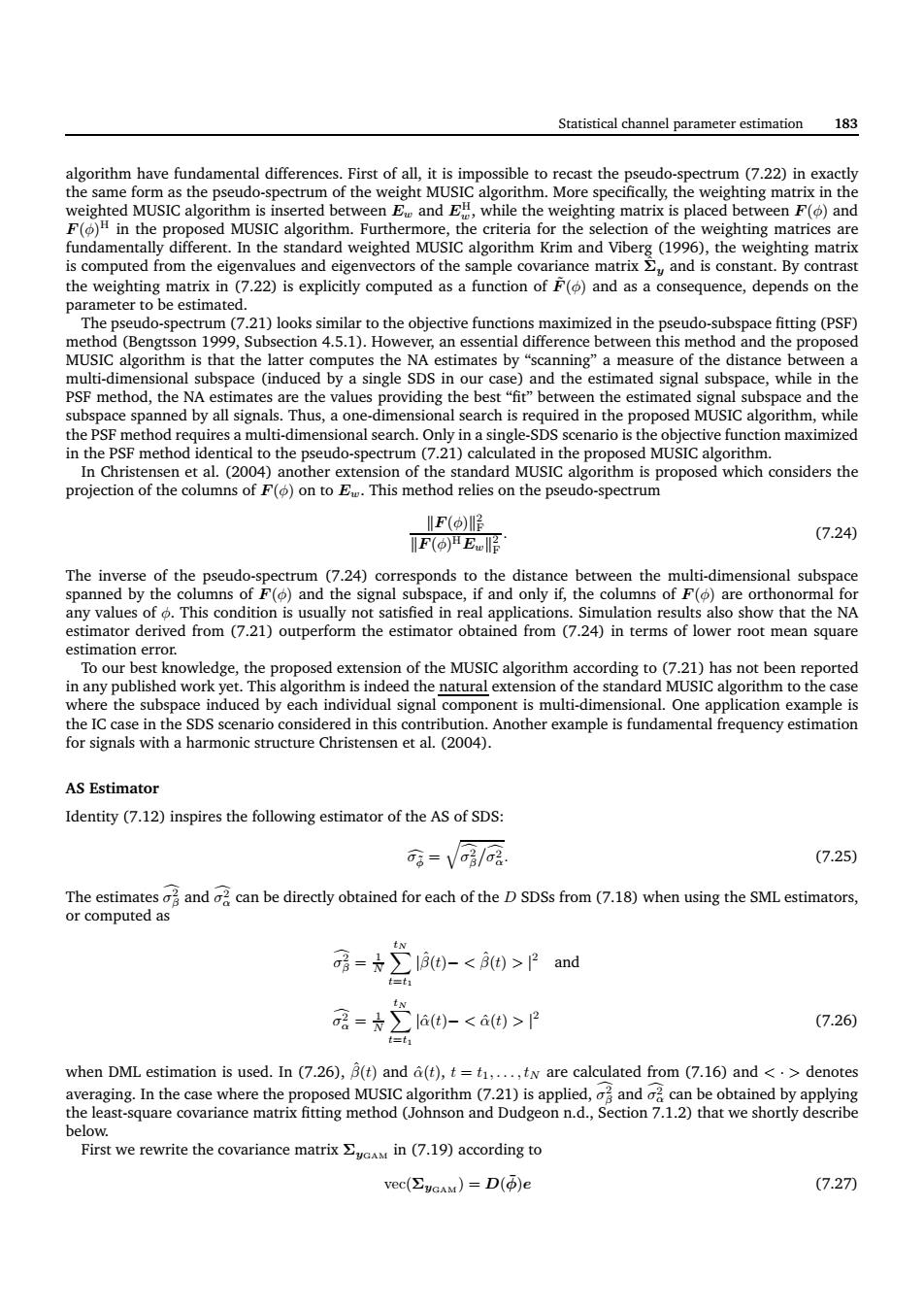正在加载图片...

Statistical channel parameter estimation 183 t of all it is im 7211 betwe n Ew and E,w hile the placed be veen F()anc (1996)the weighting matri is computed from the eigenvalues and eigenvectors of the sample covariance matrix and is constant.By contrast (7.22)is explicitly computed as a function of F()and as a consequence,depends on the Bengm is tha the NAs etween this metod and the proposec )and the estimated signal subspace,while in the ired in he estimat th ar the PSF method requires a multi-dimensional search.Only in a single-SDS scenario is the objective function maximized in the PSF method id al ic to the pseudo-spectrum (7.21)cale d in the proposed MOSIC rooof the comofontoThis method relies on the pseudo-spectrum considers the IF( (7.24) F()E. any values of This condition is usually not satisfied in real applications.Simulation show that the NA estimator derived from(7.21)outperform the estimator obtained from(7.24)in terms of lower root mean square Toour best knowledge,the proposed extension of the MUSIC algorithm according to(7.21)has not been reported in any publi hed wor s algorithm is indeed the natural ext on of the standar USIC algorithm to the c the IC case in the SDS scenario considered in this contribution.Another example is fundamental for signals with a harmonic structure Christensen et al.(2004). AS Estimator Identity (7.12)inspires the following estimator of the AS of SDS =VG/屈 (7.25) =+20-<0>P 2=六∑6()-<a0>P (7.26) when DML estimation is used.In (76),()and), 1 we rewrite the covariance matrixin (7.19)according to vec()=D()e 7.27刀 Statistical channel parameter estimation 183 algorithm have fundamental differences. First of all, it is impossible to recast the pseudo-spectrum (7.22) in exactly the same form as the pseudo-spectrum of the weight MUSIC algorithm. More specifically, the weighting matrix in the weighted MUSIC algorithm is inserted between Ew and EH w , while the weighting matrix is placed between F(φ) and F(φ) H in the proposed MUSIC algorithm. Furthermore, the criteria for the selection of the weighting matrices are fundamentally different. In the standard weighted MUSIC algorithm Krim and Viberg (1996), the weighting matrix is computed from the eigenvalues and eigenvectors of the sample covariance matrix Σˆ y and is constant. By contrast the weighting matrix in (7.22) is explicitly computed as a function of F˜(φ) and as a consequence, depends on the parameter to be estimated. The pseudo-spectrum (7.21) looks similar to the objective functions maximized in the pseudo-subspace fitting (PSF) method (Bengtsson 1999, Subsection 4.5.1). However, an essential difference between this method and the proposed MUSIC algorithm is that the latter computes the NA estimates by “scanning” a measure of the distance between a multi-dimensional subspace (induced by a single SDS in our case) and the estimated signal subspace, while in the PSF method, the NA estimates are the values providing the best “fit” between the estimated signal subspace and the subspace spanned by all signals. Thus, a one-dimensional search is required in the proposed MUSIC algorithm, while the PSF method requires a multi-dimensional search. Only in a single-SDS scenario is the objective function maximized in the PSF method identical to the pseudo-spectrum (7.21) calculated in the proposed MUSIC algorithm. In Christensen et al. (2004) another extension of the standard MUSIC algorithm is proposed which considers the projection of the columns of F(φ) on to Ew. This method relies on the pseudo-spectrum kF(φ)k 2 F kF(φ)HEwk 2 F . (7.24) The inverse of the pseudo-spectrum (7.24) corresponds to the distance between the multi-dimensional subspace spanned by the columns of F(φ) and the signal subspace, if and only if, the columns of F(φ) are orthonormal for any values of φ. This condition is usually not satisfied in real applications. Simulation results also show that the NA estimator derived from (7.21) outperform the estimator obtained from (7.24) in terms of lower root mean square estimation error. To our best knowledge, the proposed extension of the MUSIC algorithm according to (7.21) has not been reported in any published work yet. This algorithm is indeed the natural extension of the standard MUSIC algorithm to the case where the subspace induced by each individual signal component is multi-dimensional. One application example is the IC case in the SDS scenario considered in this contribution. Another example is fundamental frequency estimation for signals with a harmonic structure Christensen et al. (2004). AS Estimator Identity (7.12) inspires the following estimator of the AS of SDS: σcφ˜ = q σc2 β σc2 α. (7.25) The estimates σc2 β and σc2 α can be directly obtained for each of the D SDSs from (7.18) when using the SML estimators, or computed as σc2 β = 1 N XtN t=t1 |βˆ(t)− < βˆ(t) > | 2 and σc2 α = 1 N XtN t=t1 |αˆ(t)− < αˆ(t) > | 2 (7.26) when DML estimation is used. In (7.26), βˆ(t) and αˆ(t), t = t1, . . . , tN are calculated from (7.16) and < · > denotes averaging. In the case where the proposed MUSIC algorithm (7.21) is applied, σc2 β and σc2 α can be obtained by applying the least-square covariance matrix fitting method (Johnson and Dudgeon n.d., Section 7.1.2) that we shortly describe below. First we rewrite the covariance matrix ΣyGAM in (7.19) according to vec(ΣyGAM) = D(φ¯)e (7.27)